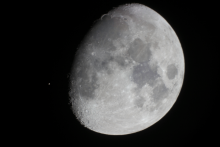Listen to today's episode of StarDate on the web the same day it airs in high-quality streaming audio without any extra ads or announcements. Choose a $8 one-month pass, or listen every day for a year for just $30.
You are here
Moon and Aldebaran
When a pot of vegetable soup simmers on the stove, about all you see at the top is the broth — the vegetables all stay at the bottom of the pot. Turn it up to a vigorous boil, though, and before long you see peas and corn and tomatoes all bubbling to the top — pushed upward by a process called convection.
The same thing is happening in the star that represents the eye of the bull. Aldebaran is nearing the end of its life, so the temperature in its core has cranked way up. That’s turned up the “boiling” action at the surface. And that is revealing elements created during Aldebaran’s long life.
Aldebaran has converted the original hydrogen in its core to helium through nuclear fusion. Right now, the helium core is getting smaller and hotter. At the same time, fusion is taking place in a thin layer of hydrogen around the core.
The heat from that process has caused Aldebaran’s outer layers to puff up. And it’s brought those layers to a vigorous boil. Hot gas bubbles up all the way up from the core to the surface. That’s dredged up smatterings of other elements created by fusion — carbon, oxygen, and nitrogen.
Eventually, fusion will ignite in the helium, converting the entire core to carbon and oxygen — creating more ingredients to bubble to the surface of Aldebaran.
And the bull’s eye follows the Moon as they climb the eastern sky in the wee hours of tomorrow morning. It’s the bright orange star to the lower left of the Moon.
Script by Damond Benningfield




